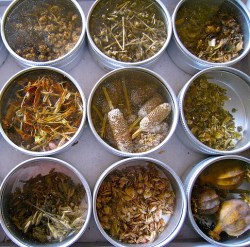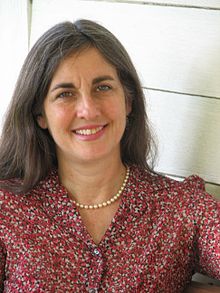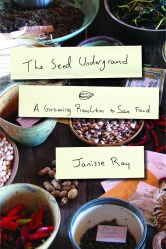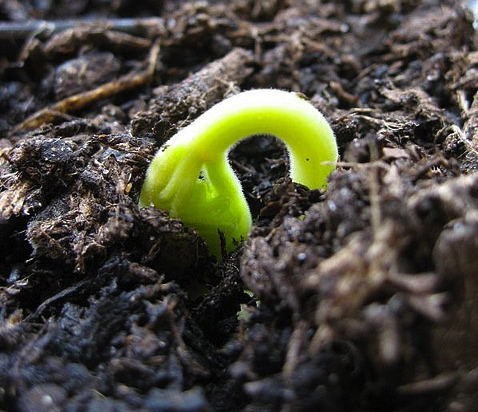
Photo by Edible Office.
“In the course of getting a plate of food to our table, we’re paying a lot of attention to the farmer, the chef, the farmers market — all of that is as it should be, but we pay very little attention to the thing that starts it all, the seed.” That sentiment comes from Janisse Ray, farmer and author of the new book The Seed Underground: A Growing Revolution to Save Food.
And it’s true; for many of us, seeds are a mysterious, invisible piece of the food puzzle. While we’re busy thinking about how to fix our food economies, seeds often slip through the cracks. And we’ve lost an almost unfathomable amount of genetic diversity as a result; depending on whom you ask, anywhere between 75 to 95 percent of our fruit and vegetable varieties have been lost for good. Highly functional, often bland, hybridized and genetically engineered varieties have taken over the commercial market — as opposed to the more delicate, complex heirloom varieties with stories and names attached, such as Dragon Tongue beans, Country Gentleman sweet corn, and May Queen lettuce — and Monsanto, Dupont, and Syngenta now own over half of the world’s seeds.
So, you might say Ray’s book has appeared just in time. In it, she makes a compelling argument for seed-saving as a subversive act that has the potential to undermine industrial agribusiness and takes readers to the farms and gardens of people around the country who are growing, collecting, and swapping seeds.

Janisse Ray.
“Our grandparents and great-grandparents were caretakers of seeds. Now we rent them,” she told me in a recent interview. Eighty-eight percent of corn is genetically engineered, for instance, says Ray, and it has been engineered so that it’s impossible to save. Every year farmers must buy new seeds from the companies that engineer them in a laboratory. On the other hand, says Ray, “100 years ago there would have been thousands of varieties of corn all across this country. Local, vintage, place-adapted corn. When seed companies patent genetic material, own it, and decide what you get to buy, it’s time to pay attention.”
Open-pollinated, non-GMO seeds also have a role to play in helping us prepare for climate change, says Ray. She describes “place adaptation” as one of the secret miracles of seeds. (It only takes around seven years of planting and seed-saving in the same location for, say, your favorite pepper variety to become adapted to where you live.)
“A seed is like a natural memory stick; it contains millions of years of DNA, it stores and reproduces climate data for generations. Among these thousands of genes are some you never know if you’re going to need, but in this time of intense climatic variability, seeds will be able to offer us avenues for survival.”
Ray points to organizations like The Organic Seed Alliance and others that are “leading farmers to breed seeds especially adapted for organic, low-input agriculture and adapted for conditions that we’re facing now, like long periods of drought.” (Their odds of succeeding are probably better over time than the “drought-tolerant” seeds Monsanto has on the market.) And while seed banks — like the one the Norwegian government has carved deep into the permafrost in the arctic circle — are both fascinating and important, Ray says an active culture of gardening and seed saving can serve the same purpose, and it’s more democratic, as most people can rarely gain access to big institutional seed banks.
 In the book, Ray brings her audience along to visit some of the people who have put seed-saving at the center of their lives — from Sylvia Davatz, a breeder who grows and sells her own seeds, to Will Bonsall of Maine’s Scatterseed Project, and Charles Case, “The Tomato Man.” She also tells stories of people like John Gilfeather, a man known for breeding and preserving his own turnip varieties.
In the book, Ray brings her audience along to visit some of the people who have put seed-saving at the center of their lives — from Sylvia Davatz, a breeder who grows and sells her own seeds, to Will Bonsall of Maine’s Scatterseed Project, and Charles Case, “The Tomato Man.” She also tells stories of people like John Gilfeather, a man known for breeding and preserving his own turnip varieties.
“They’re revolutionaries who would never call themselves that, who have been keeping these foods alive. Sometimes it’ll be one cantaloupe variety in a family — they grow it, then their kids and grandkids grow it. Or sometimes it’ll be one person curating hundreds of varieties, like Glenn Downs [of the Sand Hill Preservation center] in Iowa.” Ray says she’s met one North Carolina gardener who grows over 50 varieties of sweet potatoes alone.
And, perhaps more important, each seed variety tells a story. “The story just keeps growing as the seeds get passed from person to person,” Ray says. “I got this bean from my friend who got it from a gardener in Mississippi, who got it from another farmer in Georgia …” By comparison, Ray points to the laboratories she’s visited, where each strain of each plant is given a name like X1247B. What is often lost — in today’s farming world — is the stories. And, as Ray sees it, stories belong at the center of our relationships with food.
In The Seed Underground, Ray details her own effort to track down the seeds for a rare cowpea (a Southern legume, similar to a black-eyed pea) she has grown and then lost. Although she ultimately gets sent a batch of the seeds, there is a moment in the book where Ray worries that the variety may no longer exist anywhere. When she calls the owners of the Baker Creek Heirloom Seeds company and they can’t find it either, she starts to worry. Then, after contacting another seed-saver, who she believes may have them, she writes:
She didn’t know that I had grown the seeds and lost them. She didn’t know that I was afraid she would check her supply and find out that she’d been mistaken, that she had lost them too. I was afraid that they were gone for good, a big X-mark on my karma.
When asked about the kind of responsibility she and other seed-savers like her feel, Ray said she hopes to awaken in eaters the sense that we all need to be responsible for keeping our food and farming genetically diverse. But for Ray, it’s a form of responsibility rooted in deep connection. Quoting Aldo Leopold, she sums it up this way: “Obligation follows on the heels of love.”
Read one excerpt from Ray’s book called “How to save tomato seeds.”



